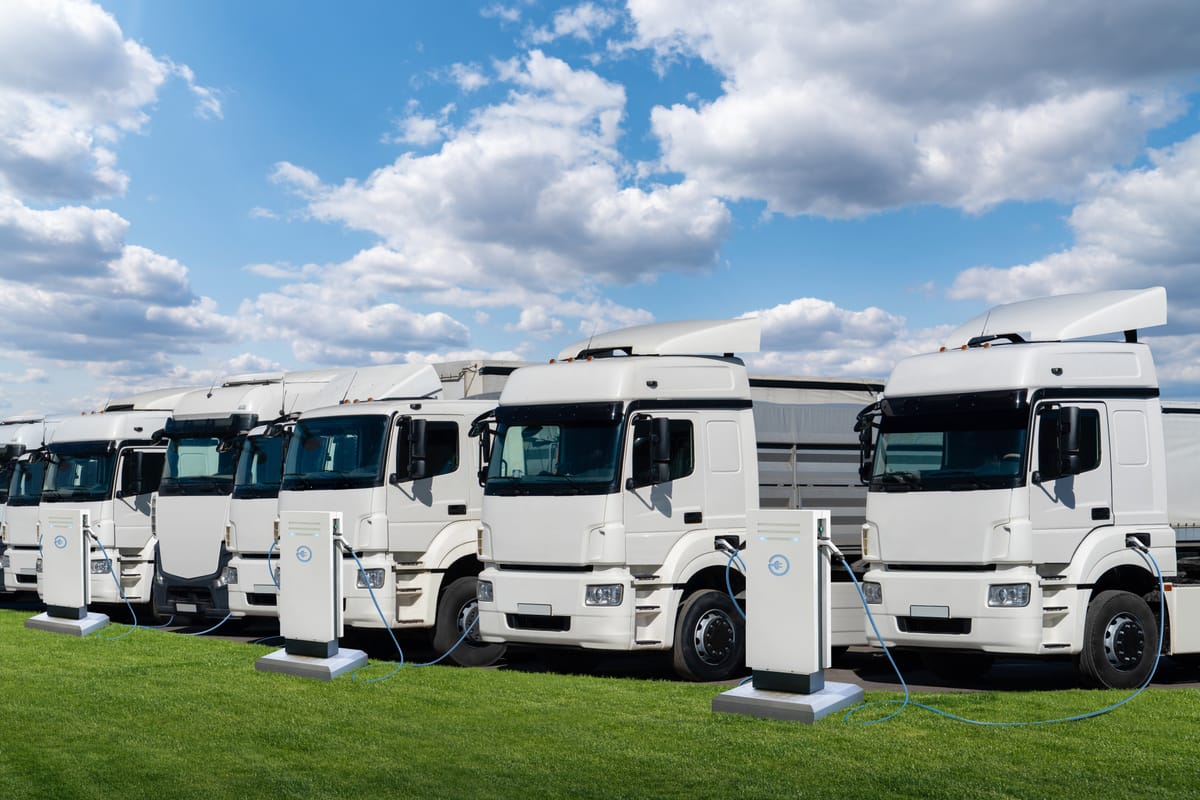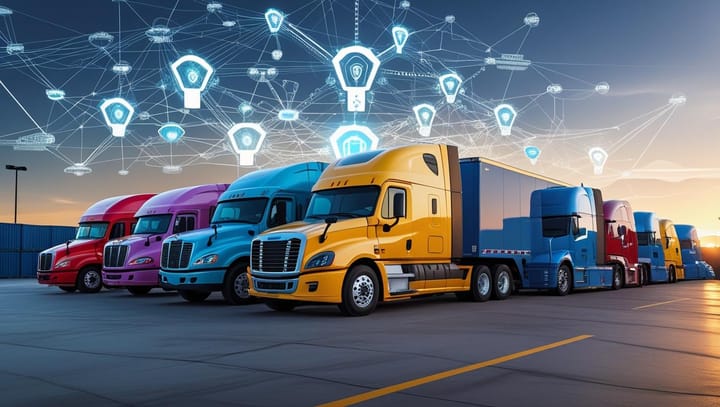EV mandate battle
Plus: How tariff bills, worker cuts and freight fraud are impacting fleets

The AI landscape in logistics can feel pretty overwhelming to fleets of all sizes. What's hype versus what actually helps? How do you pay for these tech stacks? We asked a transportation expert for advice on how trucking execs and fleet owners can make AI work for them.
Meanwhile, economic pressures are hitting the trucking industry hard, with a Volvo truck plant announcing layoffs and regulatory battles heating up over electric truck mandates. Plus, with freight rates in flux and insurance premiums on the rise, trucking businesses are navigating a landscape full of financial and operational challenges. In tech news, Google's delay in phasing out third-party cookies has implications for digital advertising in trucking.

⬇️$3.635
AVG. COST OF DIESEL PER GALLON IN U.S. AS OF 3/3, DOWN 0.062¢
Source: U.S. Energy Information Administration

Making the business case for AI in trucking
AI is the buzzword of the decade. The question is how to take it from buzzy new tech to practical, cost-effective options in trucking.
For the answer to that, along with what to do and not do when implementing AI into your trucking business, we spoke to Jonathan Todd, vice chair of the Transportation & Logistics Practice Group at law firm Benesch. - Shefali Kapadia
There's a lot of hype around AI. What are practical use cases you've seen for AI in the trucking industry?
One of the most practical applications for AI in the trucking sector is for routing of equipment. Products exist today that can provide mathematically sound answers to questions around lanes and deployment of assets. This can greatly assist in the role of fleet managers and allow them to focus on other more impactful functions.
Some other more administrative applications that companies are exploring include collecting and analyzing customer load requests, preparing transportation documents and assisting with communications.
What's the biggest mistake you see fleet execs make when they start to think about or implement AI?
There is a misconception among some that AI is essentially a low-cost employee that works 24/7 without oversight. Your business is still your business. The risks and challenges will remain even if AI assists in operational functions. Like most things, human intervention is important in any decision-making, and buy-in from your team is essential to make any implementation project a success. Tackling these projects often begins with recognizing the potential uses, identifying what functions are intended and what are off-limits, and determining who within the organization will take the lead on managing the project as well as day-to-day use.
If an exec feels overwhelmed by the AI landscape, what's the first step they should take?
The first step is to gain a realistic understanding of what AI is and what it is not. Vocabulary can be a challenge, such as the distinction between generative AI and algorithmic AI. Plenty of guides, webinars and events exist in today’s market that can take the edge off the learning curve. The next step is to gain an understanding of products on the market and to see demos of those. Not everything will be a one-size-fits-all solution, but surveying the “lay of land” will help to gain a sense of what is available and the costs.
How can small business trucking owners make the business case for AI and implement solutions in a cost-effective way?
Many vendors of AI solutions will have statistics available showing the intended benefit of using their platforms. Those could include dollars-and-cents savings like increased revenue per mile, increased equipment utilization, lower occurrence of human error and increased efficiency for office staff. There are other indirect benefits that cannot be overlooked as well. For example, if your shipper customers are asking questions about AI, then having a good honest answer may help to secure years of future work.

Why it makes sense to pay attention to other trucking sectors
Does your trucking business haul mainly in the Midwest? Are you focused on cross-border shipments between the U.S. and Canada? Then the drayage trucking sector, focused on hauling to and from seaports, may feel like a distant cousin. But it's still worth paying attention to the risks and market factors affecting drayage, argues Toni Pisano, chief customer officer at PortPro Technologies, Inc.
Why? "Shifts at every link in the supply chain ripple down to affect your business," Pisano writes.
Why this matters: Trucking, logistics and supply chains are so interconnected that a move in one link can affect the entire chain. Trucking executives and other business leaders benefit from staying informed, so they can be prepared for any changes that might come their way.
Get more details at Forbes.

MAKE A DEAL: East Coast dock workers ratify contract, ending strike fears
CHECK IT TWICE: CVSA shares checklist ahead of annual Roadcheck event
LAYOFFS: 250-350 workers to be laid off at Volvo truck assembly plant
DOWN TREND: Funding craters for logistics, supply chain startups

"It only takes one scam to completely ruin a small trucking business." - Lewie Pugh, OOIDA
Pugh spoke on Capitol Hill last week about the rising problem of freight fraud in the trucking industry. Small business owners are among the most vulnerable to this crime, and if they're held liable for lost cargo, it can cost them their business. Pugh pushed for greater protections so that small business trucking owners don't have to fight this risk. Watch his testimony here.

Trucking groups back electric truck rollback bill
A new bill, dubbed the Transportation Freedom Act, would end electric truck mandates and state emissions waivers. And it got a round of applause from the American Trucking Associations.
The bill would "put us back on the path to lowering emissions without causing supply chain disruptions," the ATA said.
Why this matters: If passed, the legislation could impact fleets across the country, particularly in states such as California that have taken a more aggressive approach to emissions reduction. The bill may provide relief to fleets who haven't adopted EVs due to costs or infrastructure concerns, but it could also create uncertainty for the trucking companies that have invested in electric trucks. (American Trucking Associations)
Future of trucking rates depends on who you ask
The trucking industry has been waiting with bated breath for an upturn in rates following one of the longest freight recessions in history. Big fleets are weighing in with their predictions. Knight-Swift and Old Dominion see positive signs, while Landstar is cautiously optimistic.
Why this matters: Trucking leaders and economists have been forecasting a turn in the market for many months, basing their predictions on shipper contract activity, changes in rates and exiting capacity. But ultimately, no one has a crystal ball. (Trucking Dive)
The factors behind skyrocketing insurance costs
It's no secret that insurance premiums are rising. The question is why, and turns out, there's not one answer. Litigation and nuclear verdicts are contributing, but so are risks related to AI and natural disasters.
Why this matters: It's imperative for fleets to have adequate insurance coverage limits and risk management strategies in place. And even with those, managers should be prepared to see their insurance costs tick up. (CCJ)

If you give trucking companies a cookie...
...they might use it to find potential customers or drivers. That's why Google's move to postpone removal of third-party cookies in Chrome is likely welcome news to many businesses including trucking firms. Cookies allow fleets to target digital ads to captive audiences, whether it's a business in need for freight services or someone looking for a career in trucking.
Why this matters: Some fleets use cookies to spot individuals who have visited trucking job boards, aiding recruitment efforts. But the delay of cookie removal also presents privacy concerns as users browse the web. (Transport Topics)

Thanks for reading today's edition! You can reach the newsletter team at editor@theinsidelane.co. We enjoy hearing from you.
Interested in advertising? Email us at newslettersales@mvfglobal.com
The Inside Lane is curated and written by Shefali Kapadia and edited by Bianca Prieto.





Comments ()